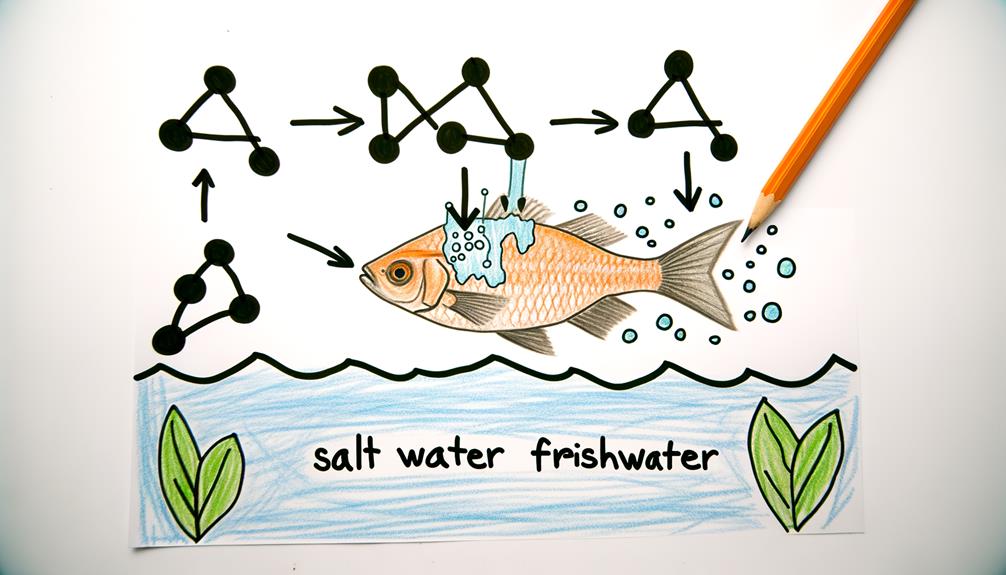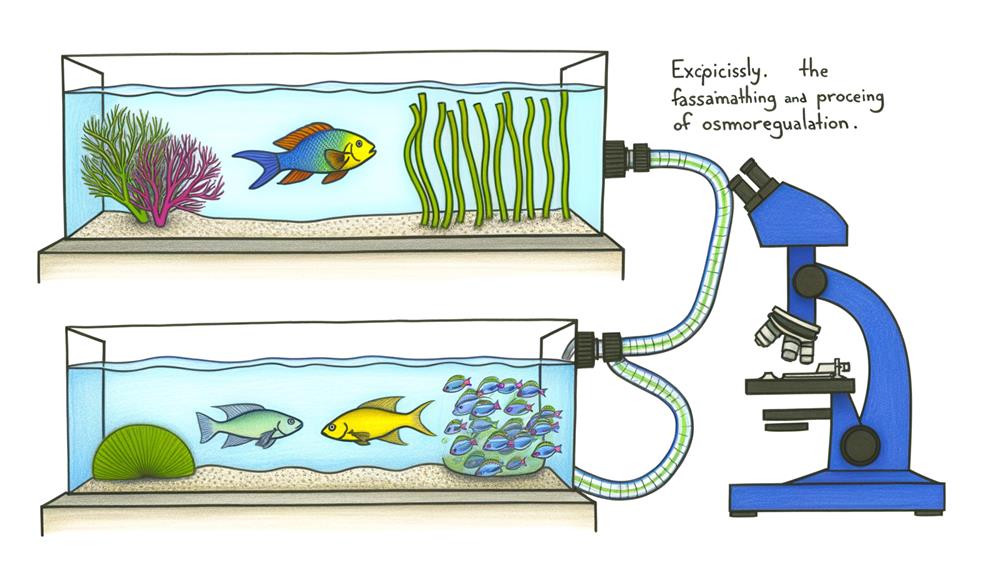The process of transitioning a saltwater fish to a freshwater environment poses substantial risks due to the significant shifts in osmotic pressure that impact the fish's physiology. The inherent need of these aquatic creatures to maintain a stable internal salt balance becomes highly challenged, causing a cascade of physiological events that can, unfortunately, lead to their demise.
This raises important questions about the adaptability and resilience of these marine organisms. So, what are the intricate mechanisms behind this phenomenon, and how do these effects manifest in the saltwater species? Let us embark on this scientific exploration.
Key Takeaways
- Freshwater exposure disrupts the salt balance in saltwater fish, causing harmful metabolic disruptions and potential cell damage.
- Saltwater fish lack the ability to regulate osmotic balance in freshwater, leading to their demise due to excessive water influx into cells.
- Euryhaline fish, however, have adaptations that allow them to transition between saltwater and freshwater habitats efficiently.
- Exposure to freshwater can result in hypotonicity in saltwater fish, affecting essential physiological functions and leading to death.
Understanding Osmosis in Fish
To fully comprehend why saltwater fish cannot survive in freshwater, one must first understand the concept of osmosis in fish, a biological process involving the transfer of water molecules across cell membranes from regions of low to high solute concentrations. This key phenomenon dictates the osmoregulation mechanism in these aquatic animals, maintaining a delicate water balance and salt concentration within their cells.
When a saltwater fish is introduced into a freshwater environment, the osmosis process is disrupted. Since the water in freshwater has a lower solute concentration than the cells of the saltwater fish, water molecules rush into the fish's cells, resulting in cell swelling. This sudden influx of water disrupts the fish's ability to regulate water and salt, which are critical for maintaining physiological functions.
The corresponding dilution of salt concentration in the fish's body impairs the fish's osmoregulation ability. This imbalance can lead to severe cell damage, as the cells struggle to maintain their volume and function. Thus, understanding osmosis is fundamental to realizing the inherent incompatibility of saltwater fish with freshwater environments, demonstrating the intricate balance needed for their survival.
Saltwater Vs Freshwater Fish Physiology
While both saltwater and freshwater fish share the basic physiological functions necessary for survival, the fundamental differences in their osmoregulatory systems underscore the distinct adaptations required for life in disparate aquatic environments. Saltwater fish, for instance, have evolved to tolerate higher salt concentrations, developing mechanisms to prevent excessive water loss through osmosis. This adaptation ensures cell stability, maintaining an optimal salt balance crucial for their survival.
The physiological response contrasts sharply when a saltwater fish is introduced into freshwater. The sudden drop in salinity triggers a rapid water influx into the fish's cells due to osmosis, disrupting the salt balance. This imbalance leads to cell swelling, which can damage organs and disrupt vital physiological functions.
Further complicating matters is the saltwater fish's inability to osmoregulate in freshwater conditions. Deprived of its natural environment, the fish experiences metabolic disruptions, which can be fatal. While freshwater fish have evolved to efficiently manage water and salt concentrations, saltwater fish lack this crucial ability. This stark contrast in physiological adaptation highlights the importance of maintaining appropriate environmental conditions for fish, further emphasizing the fundamental differences between saltwater and freshwater fish physiology.
Osmotic Pressure Impact on Fish

When a saltwater fish is placed in freshwater, there is an immediate impact on the osmotic pressure of the fish's cells. The lower salinity levels in freshwater environments cause water to flood into the fish's cells, leading to cell swelling and a disruption in the body's salt balance.
This alteration in osmotic pressure can cause significant physiological dysfunction, negatively affecting the fish's ability to osmoregulate and potentially leading to cell damage.
Understanding Osmotic Pressure
Osmotic pressure, the potent force that dictates water movement across a semipermeable membrane, profoundly influences the physiology of fish by managing water balance and cell function when subjected to varying salt concentrations.
In the ocean, saltwater fish survive due to the concentration of salt in their bodies being similar to the highly concentrated marine environment. This balance allows for a steady water flow through their cells.
Conversely, freshwater fish survive in an environment where the concentration of salt is much lower than in their cells. Thus, water tends to flow into their bodies, and cells accumulate excess water.
Understanding how osmotic pressure facilitates these adaptations provides insight into the intricate survival mechanisms of different fish species.
Saltwater Fish Adaptation
In the context of aquatic survival, the adaptation of saltwater fish to varying osmotic pressures plays a critical role. Particularly when these marine creatures are placed in a freshwater environment, saltwater fish cannot live in freshwater. This is because their bodies are heavily concentrated with salt, a condition highly incompatible with freshwater habitats. The surrounding water in such a context is less concentrated, causing a flow of water into the fish's cells. Consequently, these cells accumulate enough water to swell and disrupt critical metabolic processes.
Ultimately, the inability of these saltwater fish to adapt to the significantly lower salinity levels, and thus manage their osmotic balance, underlies why they cannot live in freshwater. The impact of these osmotic pressures vividly demonstrates the vital importance of appropriate environmental adaptation.
Saltwater Fish Survival in Freshwater
The survival of saltwater fish in freshwater environments is severely compromised due to a variety of physiological disruptions, primarily caused by the absorption of excess water into the cells. This results in the cells swelling up and causing significant cell damage and rupture. The fish's overall health deteriorates rapidly as the internal osmotic balance is disrupted, owing to a skewed salt balance.
In this new environment, heavily concentrated in salt, the fish struggles with several challenges:
- The disruption of metabolic processes, which are vital for the fish's survival.
- The fish's inability to maintain the necessary salt balance, leading to an imbalance of internal osmotic pressure.
- The impairment of respiration and nutrient exchange, crucial for the fish's overall health.
- The resultant damage and rupture of cells, a direct threat to the fish's survival.
This scenario starkly contrasts with freshwater fish survival, where the organisms are adapted for lower salt concentrations. Thus, placing a saltwater fish in freshwater does not only threaten its survival but also disrupts the natural order of aquatic life.
Fish Osmoregulation Experiments

Often, scientists utilize osmosis experiments with fish to effectively illustrate the severe physiological consequences that occur when saltwater fish are placed in freshwater environments. This process is largely due to osmoregulation, an essential mechanism that helps fish maintain their internal water balance despite differing salinity levels.
Euryhaline fish, a diverse group capable of surviving in both freshwater and saltwater environments, offer fascinating insights into the adaptations necessary for such survival. These species showcase the importance of osmoregulation, and their study can elucidate why disruptions in salt balance can prove fatal for saltwater fish in freshwater.
The following table presents a brief overview of the critical role of osmosis and osmoregulation in the survival of fish:
| Term | Description |
|---|---|
| Osmosis | Allows the passive movement of water across cell membranes, influencing fish survival in varying salinity levels |
| Osmoregulation | The active regulation of osmotic pressure to maintain homeostasis and internal water balance |
| Euryhaline Fish | Fish species with adaptations to survive in both saltwater and freshwater environments |
| Disrupted Salt Balance | A condition that can lead to the death of saltwater fish when exposed to freshwater environments |
These findings underline the importance of understanding osmoregulation, vital for the survival of fish in varying aquatic environments.
Case Study: Saltwater Fish in Freshwater
Exposing saltwater fish to freshwater environments triggers complex physiological responses, characterized by cells absorbing an excess of water that often leads to cell rupture. The mechanism behind this phenomenon is grounded in the principle of osmosis, where water flows from a less concentrated solution to a more concentrated one.
Saltwater fishes, acclimated to living in ocean water, have bodies that are highly concentrated in salt solution. When these fishes are placed in freshwater, their bodies become a region of higher salt concentration compared to the surrounding water. Thus, water flows into the fish, causing cells to swell and potentially burst because water absorption surpasses the capacity of the cells to handle it. Consequently, the fish can't survive in such conditions.
The following effects occur upon the transition of fish from saltwater to freshwater:
- Disruption of metabolic processes due to salt concentration imbalance
- Malfunctioning of regulatory systems responsible for osmoregulation
- The fish's body turning hypotonic, affecting essential physiological functions
- Eventual death of the fish due to non-adaptability to freshwater conditions
Understanding the complex interplay between freshwater and saltwater environments provides us a sense of belonging in the intricate web of life.
Frequently Asked Questions
Can a Saltwater Fish Survive in Freshwater?
Due to osmosis impact, survival chances of saltwater fish in freshwater are minimal. Saltwater gills, evolved for high water salinity, struggle with freshwater tolerance. Environmental stressors and lack of aquatic adaptations exacerbate this issue.
What Would Happen to a Salt Water Fish in a Fresh Water Tank?
When a saltwater fish is placed in freshwater, osmotic shock consequences occur. This disrupts the fish's salinity balance and alters gill functionality, causing cellular damage and potential gill tissue destruction, impacting the fish's metabolism and survivability.
Can Saltwater Fish Adjust to Freshwater?
Saltwater fish cannot adjust to freshwater due to osmotic shock consequences. Their gills functionality change, causing saltwater species sensitivity and organ damage risks. Survival rate factors include salinity tolerance levels and behavioural changes observed.
What Happens if a Marine Fish Is Placed in a Freshwater Aquarium?
When a marine fish is placed in freshwater, it experiences salinity shock affecting gills functionality. Osmosis consequences lead to cell damage and metabolic changes. Behavioral alterations occur, reducing survival chances. This often results in fish mortality.
Conclusion
In conclusion, introducing saltwater fish to freshwater environments is akin to a fish out of water scenario, leading to severe osmotic disruption and potential fatality.
Their specialized physiology, adapted to hypertonic marine conditions, fails to cope with the sudden shift in salinity, causing cellular damage and metabolic dysfunction.
Thus, it is crucial to maintain appropriate saline conditions for marine organisms to ensure their survival and well-being.


